Ancient Rome is a HUGE unit. There's so much information to cover and it's hard to figure out when to teach what and how to get it all to fit in the time you have to allocated to it. So, I thought it would be helpful to show you how I plan it out.
A few things before I get started: When you are planning, it helps to divide your class into 2 short chunks for 40 minute classes, 2-3 chunks for 55 minute classes, and 2-5 chunks for 90 minute classes. Each chunk represents a different type of activity (bell ringer, notes, group work; video, notes, coloring page; discussion, video, notes; notes, group work, more notes, etc.). The content breakdown below is for a 90 minute class. In a 90 minute class, I really only want students to take notes for about 45 minutes - this 45 minutes could be all at once or broken into 2 smaller segments. The rest of class is used for discussion, group work, map activities, independent research, whole class activities, etc. If you have a shorter class, you will need to break the content into smaller chunks so students are only taking notes for half of the class. If you have students who struggle with note taking, using fill in the blank notes or a coloring page version may help.
When I create my Doodle Notes, I create 3 versions:
(1) A blank version for students who have no trouble taking notes
(2) A fill in the blanks version of notes to give to students who need some extra scaffolding - these also work well when you need to cover something quickly like when snow days, fire drills, assemblies, etc. reduce your class time
(3) A version that is completely filled in - I call it a coloring page version because even though the content is filled in for students, there are still tasks like coloring in a map or answering questions that need to be done so students still interact with the material (this interaction is key - it's what helps students learn and retain the content!)
These different versions can be distributed to different students based in their needs. And, then the entire class can take notes using the PowerPoint/Google Slides presentation together.
Breaking down Ancient Rome
Day 1: Geography and Founding of Rome
On the first day of the unit, students learn how geography affected the founding of Rome including the myth of Romulus and Remus with Doodle Notes or guided notes.
Day 2: Life in the Republic (Society & Religion)
Before Ancient Rome became an empire with an expansive territory, they were a Republic. So, today, students will use Doodle or guided notes to learn about the social structure of the Republic between Patricians, Plebeians, the Liberti (freed slaves), and Slaves; how the conflicts between the Patricians and Plebeians led to the 12 Tables; the roles of men and women; and the Roman gods and goddesses (if you need to break this lesson into smaller chunks - a day on the social structure and the conflicts and another day on the roles on men/women and the Roman gods/goddesses works well).
This is a tough one. It was probably my least favorite lesson in this unit until I created a Doodle Notes set that breaks things down and makes the structure a lot easier for students to understand. Students will learn about the tripartite government that is made up of the Magistrates (all the elected positions), the Senate, and the Assemblies (if you need to break this lesson into smaller chunks - a day on the Magistrates, a day on the Senate, and another on the Assemblies is a great way to divide it up).
This is a lesson many students enjoy. Students will learn about the structure of the Roman Army and then learn about the 1st (naval battles), 2nd (Hannibal!), and 3rd Punic Wars (goodbye Carthage) using Doodle Notes or guided notes (If you need to break it up, consider a day on the Roman Army and another on the Punic Wars).
It's time to say goodbye to the Republic as students learn about the 1st and 2nd Triumvirates (and a little about Cleopatra) using Doodle Notes or guided notes.
In this lesson students will use Doodle Notes or guided notes to learn about the Roman Empire beginning with Augustus and covering the Julio-Claudian Emperors, Flavian Emperors, and the 5 Good Emperors using Doodle Notes or guided notes (if you need to break this content up, consider a day on Augustus, a day on Julio-Claudian and Flavian Emperors and another day on the 5 Good Emperors).
After learning about all the emperors, this lesson uses Doodle Notes or guided notes to take a look at life in the Empire from entertainment and gladiators to the major achievements of the Roman Empire.
In this lesson, students use Doodle Notes or guided notes to learn about the Jews living in Judea under the control of the Roman Empire and the revolts in 66 AD/CE and 132 AD/CE, how Christianity emerged with the birth and life of Jesus, the persecution of Christians, the end of persecution and the early Christian Church (Need to break up this content? Consider a day on Jews in the Roman Empire, another on the birth and death of Jesus, and another on the early Christian Church).
As we near the end of the Roman Empire, this lesson uses Doodle Notes or guided notes to cover the major events leading up to the Fall of Rome including the reigns of Commodus, Diocletian, Constantine, and Theodosius (break this content down further by spending one day on Commodus and Diocletian and another on Constantine and Theodosius).
After looking at the events that led to the fall of Rome, this lesson uses Doodle Notes or guided notes to examine the problems that led to the Fall of Rome.
My absolute favorite way to end this unit is with a simulation where students try to see if they can stop the fall of Rome (hint: they can't)! The simulation really helps them understand all the different factors that led to the fall. And, what's best, is that they don't even realize they are learning when they play it!



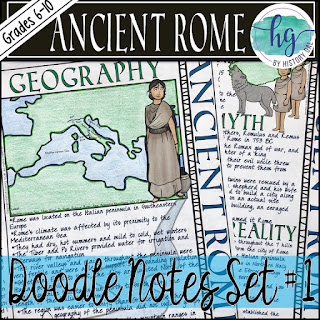
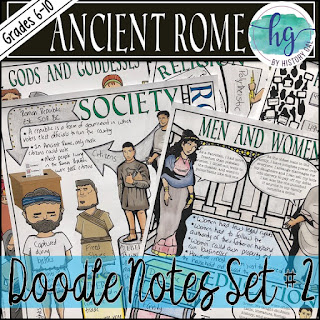


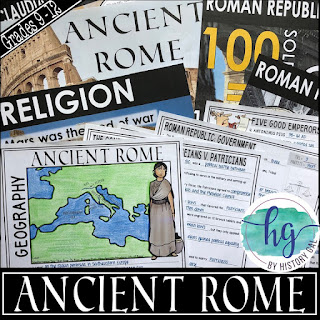

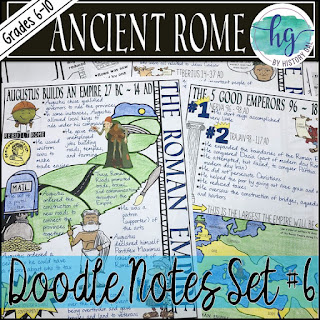
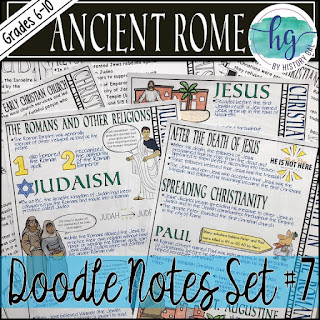

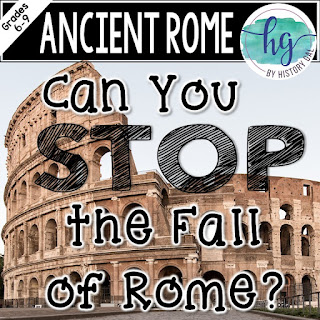






No comments
Thank you for leaving a comment! Comments must be approved before they are posted so there will be a delay in submitting a comment and seeing it on the site.